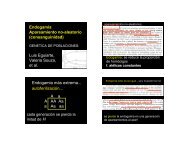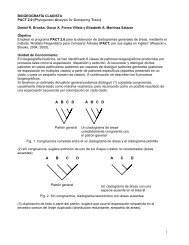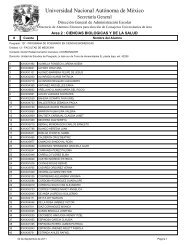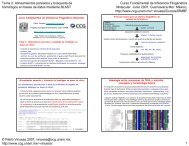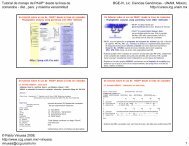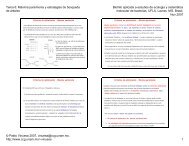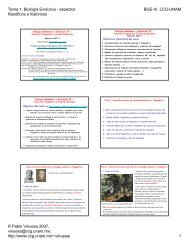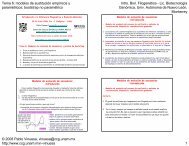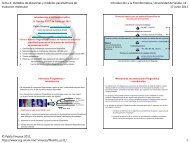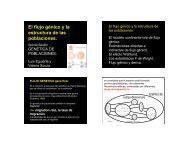<strong>Chromosome</strong> <strong>Structure</strong>breaks down once per cell cycle to distribute the 46 diploidchromosomes equally between two daughter cells.PlectonemicParanemicPlasmidsIn addition to the large chromosome, many (most?)bacteria have additional DNA molecules called plasmids(or episomes.) Plasmids are separate DNA molecules thatcontain a replication origin which allows them to multiplyindependently ofthe host chromosome. Plasmids range insize from 1 kbp (Kilo base pair) (1000 bp) to 100 kbp, andthese DNA molecules encode genetic systems for specializedfunctions. Some plasmids make extracellular appendagesthat allow bacteria to infect and colonize sensitiveeukaryotic hosts. Plasmids often carry genes that confer onbacteria the ability to survive in the presence ofantibioticssuch as tetracycline, kanamycin and penicillin. Manyplasmids also contain genes that promote DNA transfer sothat plasmid genes can move into other bacterial species.Plasmid transfer has caused the emergence of bacterialpathogens that are resistant to most ofthe usefulantibiotics in medicine, with notable examples includingmultidrug-resistant strains of Staphylococcus and Mycobacteriumtuberculosis.In most eukaryotes, plasmids are rare. However, S.cerevisiae contains a plasmid called the 2-m circle whichefficiently partitions to new daughter cells at every celldivision. This DNA serves as a convenient module for genecloning and performing genetic experiments in yeast.<strong>Chromosome</strong> ShapeOn a macroscopic scale, bacterial chromosomes are eithercircular or linear. Circular chromosomes are mostcommon, at least among the best-studied bacteria. However,the causative agent ofLyme disease, Borreliaburgdorphei, has a 2-Mb linear chromosome plus 12different linear plasmids. Eukaryotic chromosomes areinvariably linear, and they have two ends, each carrying aspecial structure called a telomere, and a organized regioncalled the centromere which allows the chromosome toattach to cellular machinery that moves it to the properplace during cell division.One critical facet of chromosome structure is that DNAis a plectonemic helix, which means that two helical strandsentwine about each other. For duplex DNA the twoantiparallel strands, often referred to as the Watson andCrick (red and blue in Figure 1), are interwound once forevery 10 bp. Because ofthis wound configuration, biochemicaltransactions that involve strand separationrequire chromosome movement (spin) about DNA’s longaxis. The processes ofDNA replication, recombinationand transcription all require DNA rotation, and duringEukaryotic chromatinSolenoidalsupercoilsσ = –0.05(a)(b)HistoneassemblyDeproteinate5kbpPlasmidGyraseInterwoundsupercoilsσ = –0.05TopoIVTopoIIProkaryotic chromatinHUH-NSFigure 1 (a) DNA is a plectonemic helix (left) rather than a paranemichelix (right), and thus it must spin axially to undergo replication,transcription and extended pairing for homologous recombination.Supercoiling in circular bacterial chromosomes is maintained by theconcerted action of DNA gyrase, which introduces negative supercoils atthe expense of adenosine triphosphate (ATP) binding and hydrolysis, andTopoI plus TopoII, which remove excess negative supercoils. Negativesupercoiled DNA adopts an interwound conformation. However,‘solenoidal’ supercoils can be stabilized when DNA is wrapped on a proteinsurface. This is the mechanism of supercoil formation in mammalian cells(centre left). Most bacteria have nonspecific DNA-binding proteins such asHU and H-NS, which stabilize supercoils but are much less effective atcondensing DNA compared with true histones (centre right). (b) Bacteriaand eukaryotes both have an enzyme, TopoIV and TopoII respectively,designed to unknot and untangle DNA.DNA synthesis the rotation speed approaches 6000 rpm.Chromosomal DNA molecules are very long and thin, soDNA must fold many times to fit within the confines of abacterial cell. How does DNA twisting transpire withoutchromosomes getting tangled up? The problem wasimportant enough that Watson and Crick considered aparanemic helix, which is a pair ofcoils that lay side by sidewithout interwinding. Strands ofa paranemic helix canseparate without rotation (Figure 1). None the less DNA isplectonemic, and keeping chromosomes untangled requiresa special class ofenzymes called topoisomerases.2 ENCYCLOPEDIA OF LIFE SCIENCES / & 2001 Macmillan Publishers Ltd, Nature Publishing Group / www.els.net
<strong>Chromosome</strong> <strong>Structure</strong>Enzymes of DNA TopologyThe enzymes that solve the untangling problem aretopoisomerases. Topoisomerases break and rejoin DNAmolecules, thereby allowing individual strands to pass onethrough another. The number ofphosphodiester bondsbroken and reformed per reaction cycle divides topoisomerasesinto two classes. Type I enzymes, which includeTopoI and TopoIII (the odd-numbered topoisomerases),break one strand per cycle, and type II enzymes (evennumbered), gyrase, eukaryotic TopoII, and E. coliTopoIV, break two strands simultaneously. These enzymeshave two important roles: they provide a swivel toallow processes such as replication and transcription toproceed unimpeded, and they untangle knots and interchromosomelinks between DNA molecules.In all organisms DNA becomes organized into supercoils,which are turns ofthe double strand over theinterwound twists ofthe Watson–Crick helix. Supercoilscan be either positive or negative; negative supercoils areopposite to the handedness ofthe Watson–Crick turns,and positive supercoils have the same handedness. Supercoildensity is defined by a term s, which represents thenumber ofsuperhelical turns divided by the Watson–Crickturns ofa double helix. Supercoiling influences theWatson–Crick structure and, like the spring, the freeenergy ofsupernegative supercoils increases exponentiallywith quantity. Enzymes that unwind DNA to carry outtheir function (RNA polymerase and DNA replisomes)may sense and utilize supercoiling energy. However, oncenegative supercoiling has reached a critical density, theWatson–Crick structure will unwind locally, forcing DNAinto alternative structures to relieve tension. Well-studiedsupercoil-dependent alternatives to the Watson–Crickform of DNA include left-handed Z-DNA, cruciforms,and triple-stranded or H-form DNA.In eubacteria, gyrase, TopoI and TopoIV maintain invivo supercoiling levels, s 520.05 to 2 0.075. Gyrase isunique for its ability to introduce negative supercoils intorelaxed, positively or negatively supercoiled DNA at theexpense ofadenosine triphosphate (ATP) binding andhydrolysis. An essential enzyme in bacteria, gyrase iscritical for DNA reactions that include recombination,replication, transcription and chromosome segregation. Invitro, DNA gyrase can supercoil DNA to a value ofs 520.1, a level at which many sequences adopt analternative structure. In vivo, s is buffered by the counteractiverelaxing activity ofTopoI and TopoIV. The secondcritical function of topoisomerases is untangling andunknotting DNA (Figure 1b). Eukaryotic TopoII and E.coli TopoIV efficiently unknot and untangle chromosomes,and after replication this activity allows thechromosomes to segregate into daughter cells.Although an average eukaryotic nucleus is larger thanan E. coli cell, nuclear DNA is even more concentratedthan bacterial DNA. Rather than being supercoiled by anenzyme such as gyrase, eukaryotic DNA is wrapped tightlyaround nucleosomes, generating solenoidal supercoils thatcondense DNA 8-fold (Figure 1). A nucleosome containsfour subunits: histones H2A, H2B, H3 and H4. If histonesare stripped from DNA by protein denaturants, eukaryoticDNA adopts the interwound structure ofbacterialchromosomes, with about the same negative superhelixdensity (Figure 1).Eukaryotes have three topoisomerases: TopoI andTopoIII are type 1 enzymes that break only one strand,and TopoII is the only type 2 activity that breaks bothstrands simultaneously. Eukaryotic TopoI removes bothpositive and negative supercoils from DNA, whereasTopoII carries out unknotting and decatenating reactions(see below). TopoI and TopoII are essential for eukaryoticcell viability; the functions of TopoIII in both eukaryotesand bacteria remain undefined.ChromatinChromatin is a term that refers not just to DNA but to theproteins attached to a chromosome. In the dimensions ofB-form DNA, E. coli is a sphere that is 6 kbp long (8 nm)and 4 kbp wide (2 nm), so the 4.6-Mbp chromosome mustbe folded many times to fit within a cell. Negativesupercoiling forces DNA into an interwound configuration(Figure 1). Interwound supercoiling is produced at theexpense ofATP by the enzyme gyrase, and supercoilingproduces two important consequences. First, the DNAmolecule doubles back on itselfso that length is halvedrelative to that ofthe linear form. Second, supercoiledbranches are dynamic so that opposing DNA sites in theinterwound network are constantly changing. A proteinbound to DNA in one supercoiling domain interacts morethan 100 times more frequently with other proteins in thesame domain than it does with proteins bound to adifferent domain. When DNA is liberated from cells bybreaking the peptidoglycan coat, chromosomes formbundled loops that represent domains. Such preparations(called nucleoids) behave as discrete bodies.Many reactions ofthe chromosome require the formationofintricate DNA–protein machines to replicate,transcribe or recombine DNA at specific sequences. Agroup of‘chromosome-associated’ proteins assists in theformation of these complexes by shaping DNA. Theseproteins are sometimes described as histone-like, althoughthey share no structural similarity with the eukaryotichistones (Figure 1). <strong>Chromosome</strong>-associated proteinsinclude HU, H-NS, intregation host factor (IHF) andfactor for inversion stimulation (FIS).HU is encoded by two genes, hupA and hupB, which areclosely related to each other and to the genes encoding thetwo IHF subunits. HU is the most abundant doublestrandedDNA-binding protein in E. coli, although it alsoENCYCLOPEDIA OF LIFE SCIENCES / & 2001 Macmillan Publishers Ltd, Nature Publishing Group / www.els.net3



